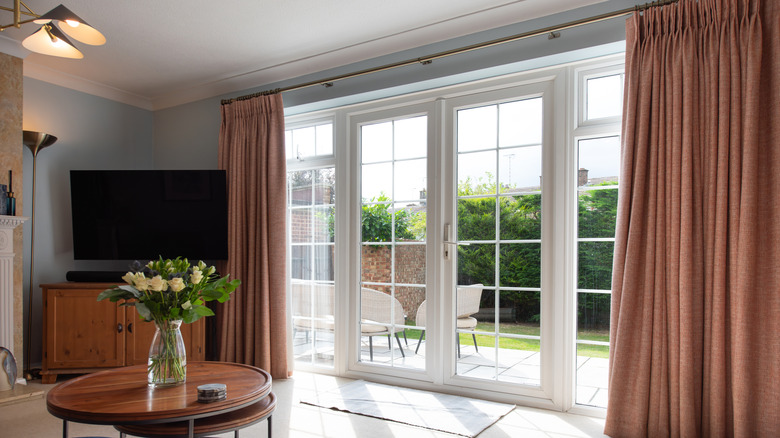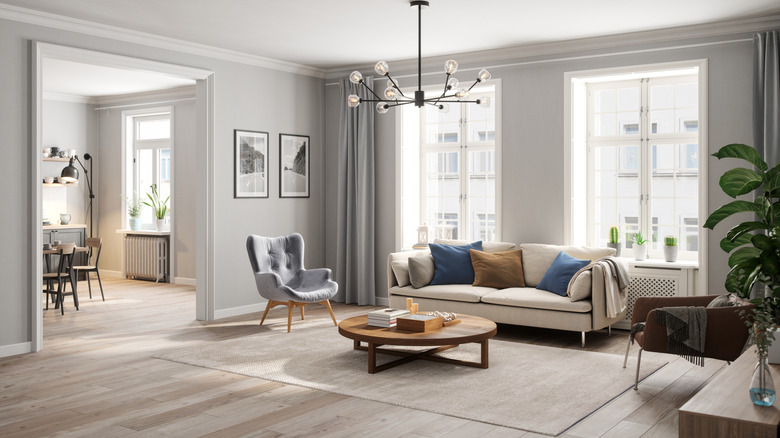Our 5 Best Tips And Tricks To Help You Choose The Perfect Curtain Rod
The curtains often steal the show when you're dressing your windows, so it makes sense to consider all your options and choose carefully to make curtains the focus of your decor. But the drapery hardware also deserves its moment in the spotlight and shouldn't be a last-minute decision. When chosen well, the right curtain rod will add to the look and have the opportunity to make a bold impact on your space, but it also need to be functional, which makes the details of the rod important. You need an option that complements the curtains while being strong enough and large enough to hold them.
When choosing the perfect curtain rod, the most important characteristics to consider include the material, type, length, circumference, color, finish, and overall style. These traits determine how good the curtain rod looks in the room and how well it's able to hold the window coverings in place. You'll need to take proper measurements to find a curtain rod that fits well. The details of your room and your curtains should also be considered when deciding upon the right hardware. Curtain rods should fit in with the overall room design style. Ensure you choose curtain rods that enhance your decor rather than compete with it.
Consider your curtains
Before you can choose your curtain rod, you need to know what you're hanging and how you want to display it. The curtains you choose will help you decide on the style and type of rod to get the finished look you want. The size and weight of your curtains also impacts what type of hanging system you need for them. Solid wood curtain rods offer the strength to hold heavier drapes without sagging. Plastic or hollow metal rods may bend in the middle under the weight of thick fabrics or large curtains, so they're better suited for lightweight curtains and smaller windows.
Looking at the curtain style, colors, and patterns will guide your rod selection by helping you find an option that coordinates with it. If you have rustic, farmhouse-style curtains, a chic, modern curtain rod may look out of place. Make sure the colors in your curtains work with the finish on your rods. For example, gold curtain rods pair well with neutral and warm colors, while a black finish looks sleek against white or gray curtains.
The curtain header type can also impact what type of rod you choose when you decorate with popular curtain styles. Grommet-top and tab-top curtains allow the bar to show through clearly, so choose a high-quality finish that you want to show in your room. Meanwhile, pinch-pleat headers work particularly well with traverse rods.
Narrow down a style
Your dominant interior decorating styles will also come into play when choosing curtain rods, as they should fit with the overall design scheme. Coordinating your rods to the rest of the decor ties it all together to create a cohesive design that flows well. Rods that are more showy will work well in maximalist styles, while basic curtain rods will look great in minimalist spaces. The material impacts the overall look of the curtain rod as well. While you can choose from a variety of designs in both wood and metal, the metal options tend to lean more toward a modern look, while wood adds a warm, rich traditional look.
The color and finish options also impact the style of the curtain rods you choose. For example, a smooth metal rod with a shiny metallic finish infuses a modern look, while a textured wrought iron rod with an aged finish represents a classic, old-world style. Wood curtain rods come in all types of standard stained finishes to help you coordinate with other wood finishes in the room and will look great in traditional, boho, and natural spaces. You can also refinish wood curtain rods if you decide you want to try unique wood finishes in the future.
Pick the type of rod
Different curtain rod types address specific issues or needs for hanging your curtains. Decorative rods attach to the wall using brackets and come in single and double configurations. A double rod is an option if you want to layer your curtains. These rods are visible and enhance the window curtain area, so choosing a finish and style that fits the room is important.
If you want the fabric to be the focal point, choose a concealed curtain hanging option. The rods attach to your wall or ceiling and are hidden by the curtains. Wrap-around curtain rods offer the same effect. The rod curves around on the end and attaches to the wall so you can pull the curtain around the corner. This option also increases privacy and blocks light around the windows.
Other rod types have specific functions. Cafe curtain rods are usually slim for lightweight cafe curtains that cover half of the window. If opening and closing curtains easily is important to you, consider a traverse rod. It works with special clips that go into a track and slide easily when you open or close the window coverings. If you're looking for a way to hang curtains without drilling, tension rods fit inside the window frame and stay in place from the pressure of the rod pushing against the frame. They work well if you're a renter and want an easy option, but the tension isn't strong enough to support large or heavy curtains.
Size it correctly
Sizing for a curtain rod includes the length and diameter, both of which are important to ensure it can handle the weight of your curtains. You can usually find curtain rods in lengths from 24 to 144 inches long to accommodate windows of varying sizes. Consider the weight and size of your curtains and where you want to hang them to help you choose.
The rods should extend beyond the edges of the window to leave room for the bunched-up curtains when you open them. How much you extend the curtain rod beyond the window frame is personal preference. The generally accepted minimum length is 4 inches or more on both sides beyond the window frame. That means if your window is 48 inches wide, your curtain rod should be at least 56 inches long. Some designers focus on the number 10, with the rod being mounted 10 inches above the window with 10 inches of overhang on either side. Heavier drapes may require a longer rod because of the bunched-up fabric.
Deciding on the diameter of the rod relates to the weight of the curtains. Heavier panels benefit from curtain rods with larger diameters because they're typically stronger. While diameters usually range from 1 to 3 inches, metal curtain rods often come in diameters less than 1 inch. Those rods are best for sheer or other lightweight curtains. The heavier and larger your curtains are, the bigger the diameter of the curtain rod should be.
Add the finishing touches
The curtain rod is the main type of hardware you should think about for window coverings, but it's not the only one. Choosing additional curtain hardware adds the perfect finishing touch to your stylish window treatment ideas. If you'd like to add something more decorative, consider using rings or hooks that hold the curtains securely and help them slide along the rod.
Furthermore, decorative curtain rods usually have finials on the ends of the bar to cover the end of the hollow tube. They give it a finished look, keep it in place, and add a little extra embellishment. Finials range from simple rounded designs in the same metal as the bar to large, highly ornate pieces made from materials ranging from glass to ceramic. Choosing bold finials make the curtain rods a focal point of the room. Alternatively, if you'd prefer them to blend in, pick a more subtle finial option.
Another hardware option is to add curtain holdbacks to the windows. You can choose from different styles, including fabric and metal. A metal holdback is usually a curved piece that's attached to the wall. When you want to hold your curtains open, grab them and tuck them behind the hook on the wall. When choosing different metal curtain hardware pieces, coordinate the finish and style so everything feels cohesive.





